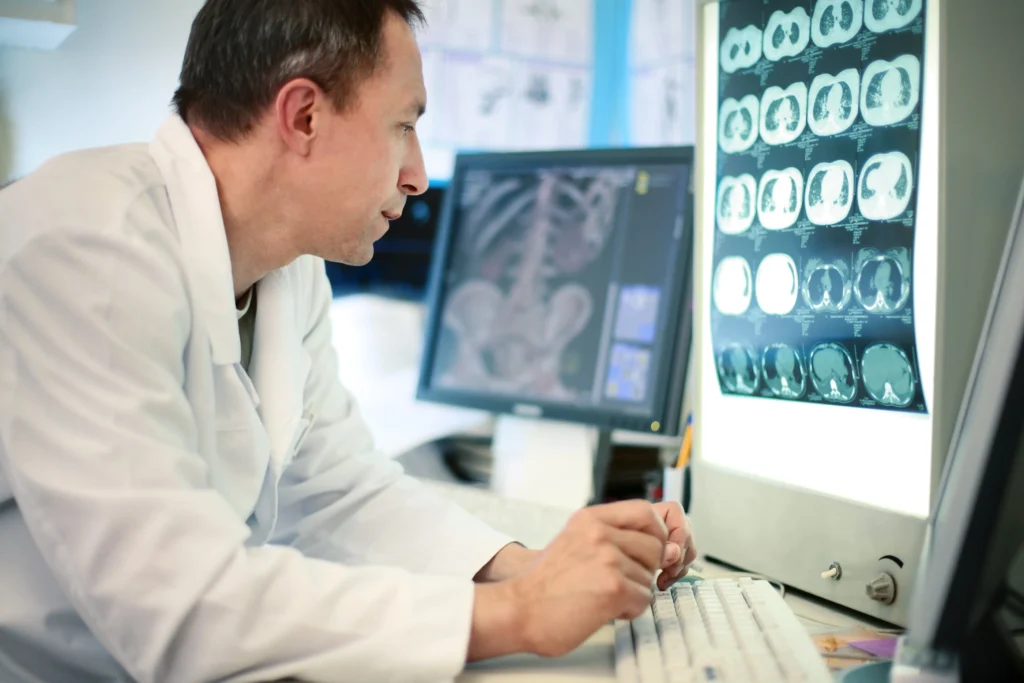Diagnostic refers to the process of identifying a disease, condition, or injury based on its signs, symptoms, and the results of various medical tests. It plays a crucial role in the medical field as it helps healthcare professionals determine the exact nature of a patient’s condition, which is essential for deciding the appropriate treatment or management plan.

- Purpose of Diagnosis:
- Identifying Diseases: The primary purpose of diagnostic procedures is to identify the disease or health condition affecting a patient. This includes both common and rare illnesses.
- Understanding Disease Progression: Diagnosing also helps understand how far a disease has progressed, which is important for staging (e.g., cancer staging).
- Guiding Treatment: A clear diagnosis helps doctors choose the most effective treatment plan for the patient.
- Monitoring Health Conditions: In cases of chronic conditions (like diabetes or hypertension), diagnostics are used to monitor the patient’s health over time.
- Types of Diagnostic Methods:
- Laboratory Tests: These are tests done on blood, urine, stool, and other bodily fluids to check for abnormalities that indicate disease. Examples include:
- Blood Tests: To check for anemia, infections, liver/kidney function, blood sugar levels, etc.
- Urine Tests: To detect kidney problems, diabetes, or urinary tract infections.
- Biopsy: A sample of tissue is taken from the body to examine for cancer or other diseases.
- Imaging Tests: These tests allow doctors to look inside the body without surgery and help diagnose conditions based on visible abnormalities. Examples include:
- X-rays: To view bones, detect fractures, or lung issues like pneumonia.
- Ultrasound: To examine soft tissues, check for pregnancies, or detect abdominal problems.
- CT (Computed Tomography) Scans: Provide detailed images of internal organs, bones, and tissues.
- MRI (Magnetic Resonance Imaging): Used to look at soft tissues like the brain, muscles, or spinal cord.
- Molecular Diagnostics: Involves studying DNA, RNA, and proteins to diagnose genetic disorders, infections, and cancers at a molecular level. Techniques include:
- PCR (Polymerase Chain Reaction): A method used to amplify and analyze DNA to detect viruses (like HIV, COVID-19) or genetic conditions.
- Genetic Testing: Detects mutations or genetic predispositions for certain diseases, like breast cancer linked to the BRCA gene.
- Microbiological Tests: These are tests to detect microorganisms (bacteria, viruses, fungi) in samples, such as blood cultures, throat swabs, and stool samples, to diagnose infections.
- Laboratory Tests: These are tests done on blood, urine, stool, and other bodily fluids to check for abnormalities that indicate disease. Examples include:
- Diagnostic Process:
- Patient History: The process begins with a review of the patient’s symptoms, medical history, and family history. This helps guide the direction of further testing.
- Physical Examination: Doctors perform a physical exam to look for signs of illness, such as abnormal heartbeats, swelling, or tenderness.
- Diagnostic Tests: Based on the initial assessment, the doctor orders diagnostic tests to gather more information. This may include blood tests, imaging scans, biopsies, or cultures.
- Diagnosis: After reviewing the results of these tests, the healthcare provider can determine the exact condition or disease affecting the patient.
- Common Diagnostic Tools:
- Clinical Examination: The first and simplest diagnostic tool. This involves asking the patient about their symptoms and conducting a physical exam.
- Blood Tests: Such as Complete Blood Count (CBC), Liver Function Tests (LFT), and Kidney Function Tests (KFT), these are routine tests for detecting infections, anemia, diabetes, liver/kidney disease, etc.
- Imaging: Technologies like X-ray, MRI, and CT scans help visualize internal structures and detect issues like fractures, tumors, or infections.
- Electrocardiogram (ECG): A test to monitor the heart’s electrical activity and diagnose heart conditions like arrhythmia or myocardial infarction (heart attack).
- Endoscopy: A procedure that uses a flexible tube with a camera to look inside the digestive system, lungs, or other internal organs.
- Importance of Diagnostic Tests:
- Accurate Diagnosis: They provide detailed information that leads to the correct diagnosis. Without proper diagnostics, doctors may misdiagnose conditions.
- Treatment Planning: A correct diagnosis is necessary to determine the most effective treatment plan (whether it involves surgery, medication, therapy, or lifestyle changes).
- Preventive Care: Diagnostics also help in identifying risk factors for diseases like heart disease, cancer, or diabetes, allowing for preventive care measures.
- Monitoring Disease Progression: Diagnostic tests are not only used to diagnose diseases but also to monitor the effectiveness of treatments and the progression of diseases.
Examples of Common Diagnostic Tests:
- Blood Tests:
- Complete Blood Count (CBC): To check for anemia, infections, and other blood-related disorders.
- Lipid Profile: To evaluate cholesterol levels and assess cardiovascular risk.
- Liver Function Tests: To check for liver diseases like hepatitis or cirrhosis.
- Blood Glucose Test: To detect diabetes or monitor blood sugar levels in diabetic patients.
- Imaging Tests:
- X-rays: For detecting fractures, lung infections, or heart conditions.
- Ultrasound: Commonly used in pregnancy to monitor the baby, but also used to detect conditions in organs like the liver, kidneys, and spleen.
- CT Scans: Used for detecting complex injuries, cancers, and internal bleeding.
- MRI: Provides detailed images of soft tissues like the brain, spinal cord, and muscles, useful for neurological or orthopedic concerns.
- Biopsy:
- A biopsy is often performed to examine tissues for cancer or other diseases. A small sample of tissue is removed from a suspected area and examined under a microscope.
- Genetic Testing:
- Genetic tests identify changes or mutations in the genes that may predispose individuals to certain conditions like hereditary cancer, genetic disorders (e.g., cystic fibrosis), and heart diseases.
- Microbiological Tests:
- Blood Cultures: To detect bacterial or fungal infections.
- PCR Tests: Used to identify the presence of viruses, such as HIV or COVID-19, by analyzing the genetic material in a sample.
The Role of Diagnostics in Healthcare:
- Early Detection: Diagnosing diseases early leads to better outcomes. For example, detecting cancer at an early stage can significantly improve survival rates.
- Disease Management: Ongoing diagnostic tests help manage chronic conditions like diabetes, hypertension, and asthma by monitoring their progress and adjusting treatment as needed.
- Research and Development: Diagnostic technologies also play an essential role in medical research, helping develop new treatments and interventions by identifying disease mechanisms and testing their effects.



